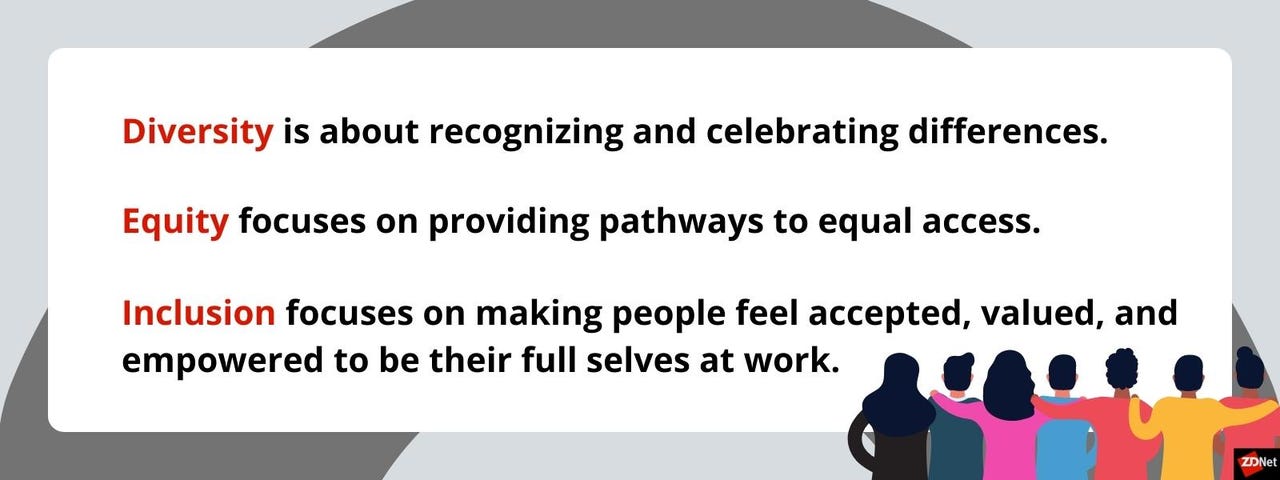Diversity in tech: What it means and how to get there

April is Celebrate Diversity Month.
Two organizations that help businesses with diversity introduced this heritage and history observance in 2004. They aimed to create an observance celebrating and honoring the diversity that's fundamental to America.
The focus on diversity is sometimes combined with equity and inclusion, or DEI for short. Diversity is about recognizing and celebrating differences. Equity focuses on providing pathways to equal access. Inclusion focuses on making people feel accepted, valued, and empowered to be their full selves at work.
Diversity can include race, gender, religion, and sexual orientation. It can also include disability, and other identities and experiences.
Tech company diversity often doesn't fully reflect our diverse world, and a lack of diversity can result in harm and unintended consequences. Diversity matters for issues like hiring decisions, leadership opportunities, innovation, and marketing strategies.
Keep reading for three ideas on how to help your organization celebrate and improve diversity.
1. Make time and space to talk with empathy
Communication is a foundational element of recognition and respect. That's especially important in our new normal. Now, much of life is — and will likely remain — virtual.
It's a time when everyone needs, and would likely appreciate, some empathy. As a result of all the social and political tension and changes, "sometimes the knee-jerk reaction is to respond by surrounding ourselves with people who are like us," LinkedIn noted.
Here are suggestions on ways to counteract that tendency, whether you're in a leadership role or just starting your career.
- Celebrate your culture or heritage through food, music, or art, and invite others to do the same (if you are white, that means your specific European ancestry, not "white" culture)
- Connect with an employee resource group (ERG) that includes people who work in your profession
2. Look beyond your network for talent
Looking past traditional channels for talent can help diversify the tech industry.
People tend to hire from within their professional networks. But one problem with that approach is that it can shut out talented people who aren't in your network. If your network lacks diversity, your hiring will too.
According to one report, about 70% of available jobs don't get publicly advertised. Instead, these positions are filled through networking. Put simply, you're missing out on talent by not connecting with people in different demographics.
Harvard Business Review suggested one possible approach to improving inclusiveness and diversity. Tech companies should double down on recruiting from communities outside the tech clusters of Silicon Valley, the Pacific Northwest, and the Northeast.
As HBR put it, "companies need to let go of their geographic biases."
So where should companies look? According to an analysis, six states have a large number of tech job-ready workers. They also have an affordable cost of living. These factors may help companies recruit and keep a more diverse tech workforce in those areas. Also, allowing people to work remotely lets them keep their social networks. That's an important factor for employee satisfaction and retention.
The states are:
- Connecticut
- Delaware
- Georgia
- Maryland
- Texas
- Virginia
3. Make DEI a full-time job (if it isn't already)
Most organizations have a chief executive team, an IT team, and marketing or sales teams. A full-time diversity, equity, and inclusion manager or team is just as important.
If you work at a small organization or the budget just isn't there right now, consider making DEI part of someone's official job responsibilities. This manager or team's responsibilities could include:
- Researching, developing, and implementing DEI policies and strategies for the organization
- Reviewing existing practices and policies and determining if they're working
- Creating internal training programs and opportunities for conversations and action
- Tracking an organization's diversity and inclusion through concrete metrics and employee surveys
If you're in a leadership role, consider these ideas to advance diversity:
- Funding, and advertising, heritage events and events celebrating diversity holidays
- Sourcing from minority-owned small businesses. The federal Small Business Administration has a database of businesses that identify or qualify as small or minority-owned
- Making ERG leadership part of someone's job description, rather than something they do in addition to their regular workload
- Partner with and donate to professional organizations for diversity and inclusion
- Ensuring all job postings get published externally, and dedicating a team or team member to vet external candidates as carefully as internal or referral candidates
- Questioning exclusion criteria: Is an advanced degree really required for that role?
- Carefully considering role requirements: Does everyone need to be in the office every day? Or is remote work a possibility?
- Changing organizational priorities to better accommodate employees who have caregiving roles for dependents (elders, children, or anyone they are responsible for without adequate support from other societal structures)
Diversity isn't just good for ethics and appearances. It's good for the bottom line.
According to Forbes, companies with diversity managers report greater diversity among managers within five years. The publication noted that diverse companies also see a 19% increase in revenue.
How are leading tech companies advancing diversity?
America's five big tech companies — Amazon, Apple, Facebook, Google, and Microsoft — stay top of mind due to their size and influence in our daily lives. Much has already been written about their efforts to increase tech's diversity.
In the spirit of diversifying conversations around tech, here's a look at where five other high-profile tech-focused companies stand on advancing diversity.
Airbnb says it is "deeply committed" to making the company, communities, and the tech industry "more diverse and accessible for everyone." Airbnb has partnered with career and talent organizations like ColorStack, Disability:IN, Stanford VMware, and BeVisible.
Adobe acknowledged that "relative to the diverse makeup of our workforce, we encountered slower progress in 2020 than we did in 2019." Adobe said diversity "metrics remained relatively flat," due in part to slow hiring and low attrition in the pandemic's early months. One of the company's initiatives includes gender-based pay parity.
IBM focuses on four areas to advance diversity and inclusion: advocacy, allyship, employee experience, and accountability. To facilitate those changes, IBM says it's focused on challenges faced by three specific groups: Women in leadership, the Hispanic community's "untapped potential," and Black leaders in business.
In its 2020 report, Intel said that more women gained senior roles. The year also saw growth in the company's Latino/a and veteran populations. Although the number of women in Intel's US workforce declined, Intel said it's focused on leadership parity and integration of diversity and inclusion processes.
Netflix noted progress in advancing diversity but added, "We're not where we want to be and we need to do better." To reach its goals, Netflix said its initiatives include increasing representation, developing a sense of inclusion, and building consciousness.
This article was reviewed by Angelique Geehan
Angelique Geehan works to support and repair the connections people have with themselves and their families, communities, and cultural practices. A queer, Asian, gender binary-nonconforming parent, Geehan founded Interchange, a consulting group that offers anti-oppression support.
She organizes as part of several groups, including the National Perinatal Association's Health Equity Workgroup, the Health and Healing Justice Committee of the National Queer and Trans Asian and Pacific Islander Alliance, QTPOC+ Family Circle, and Batalá Houston.
Angelique Geehan is a paid member of the Red Ventures Education freelance review network.
Last reviewed March 24, 2022.
